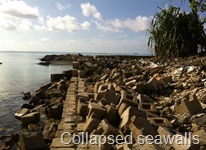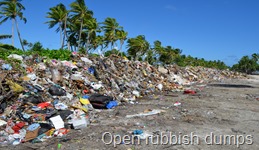 In 2013 we produced a short (18 minute) video designed to introduce the idea of building core resilience for heavily urbanised atoll islands in general, and for Funafuti in particular.
In 2013 we produced a short (18 minute) video designed to introduce the idea of building core resilience for heavily urbanised atoll islands in general, and for Funafuti in particular.
As noted on the Environmental Vulnerability Index (EVI) site the natural environment is unequivocally the life support system for all human endeavours. Far from being a luxury available only to those countries that can ‘afford’ it, successful environmental management will increasingly become the basis for the success or failure of the economies and social systems. Environmental management now occurs within countries in response to particular developments and at regional or global scales through international agreements. It is rarely strategic. Although critical to managing our life support systems, those approaches do not quite go far enough to ensure a sustainable and resilient future. They do not always focus on optimisation or the cumulative outcome of our development actions over different scales of time or space.
The now widespread environmental degradation and loss of resilience occurring in many Pacific islands is mostly due to poor choices on the types of developments we agree to. In an upcoming post we will discuss the difference between ‘big country’ engineering and the types of interventions needed for atolls.
The state we are in now shows that more than ever that we need tools that focus our efforts on planned outcomes. With the current focus on disaster risk management / reduction and impacts of extreme climatic events (like Cyclone Pam), building the resilience of our islands has never been more urgent.
What is Core Resilience?
Resilience is the ability of the environment, social systems and/or economies to resist damage due to hazards (like cyclones or any number of natural or human hazards). Generally speaking, if our islands are in good condition with productive reefs, a strong natural sand supply being generated on the reefs and in the lagoons and little degradation of defence systems like forests, beaches and beach ridges, we could say the island will be more resilient to being damaged by a whole suite of things. This includes cyclones, droughts, tsunamis, climate change and sea level rise.
On the human side there may be other hazards like changing world prices for commodities, introduction of disruptive technologies (like mobile phones) or the establishment of trade agreements – these may affect social and economic vulnerability. Taken together, Environment, Social and Economic development are considered the ‘3 Pillars’ of sustainable development.
 Funafuti now has 6,200 people living on 2 islets called Fogafale (142 ha) and Tegako (19 ha). People are not spread evenly over that area and the islets, connected by a causeway, are very long and thin with most people concentrated in a central area (red marked) which is a lot smaller. There has been serious damage to the island which is the life support system for the people living there and damage from extreme events is resulting in more and more impact with each passing year.
Funafuti now has 6,200 people living on 2 islets called Fogafale (142 ha) and Tegako (19 ha). People are not spread evenly over that area and the islets, connected by a causeway, are very long and thin with most people concentrated in a central area (red marked) which is a lot smaller. There has been serious damage to the island which is the life support system for the people living there and damage from extreme events is resulting in more and more impact with each passing year.
This prompted us to ask:
- What does resilience mean for Funafuti?
- What aspects of the island and its processes were keeping it resilient and how have those changed to make it so vulnerable now?
- Is there a core set of actions we could take to restore natural resilience or augment it if needed because there are now too many people to fully rely on natural processes?
The Funafuti Masterplan for Building Core Resilience
The video available here describes some of the history of environmental change on Funafuti since World War II and some of the projects that could be undertaken to reverse some of the damage and build the island’s core resilience. In another post, we will describe the reasons for selecting these interventions in more detail.
History
Funafuti is the capital of Tuvalu, has undergone many changes since World War II. Some of the changes have been developments that have improved living conditions for the population, giving it access to better housing, transport, communications and other goods and services and increasing the standard of living.
But some of the changes have come with large environmental costs that have negatively impacted public health and safety and reduced some aspects of quality of life. Is there a way to improve the positive changes and decrease the negative ones?
In 1987 Funafuti was still a quiet place. The population was low, there were few developments and the environment was clean. There were very few cars and motorbikes and most people travelled on bicycles and boats, or they just walked. The lagoon was crystal clear and the land was uncrowded, with little rubbish. There were lots of large trees and a village feel to the place.
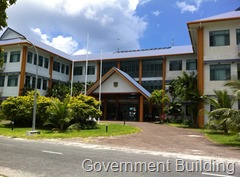 Since that time there have been many improvements. We have more permanent housing, a new government building, power station and airport. The new Vaiaku Lagi Hotel was built and we have better communications, including internet, and transport within Funafuti and to and from the outer islands.
Since that time there have been many improvements. We have more permanent housing, a new government building, power station and airport. The new Vaiaku Lagi Hotel was built and we have better communications, including internet, and transport within Funafuti and to and from the outer islands.
All of these changes mean that people have better access to the outside world and life has become easier meaning more opportunities for human development.
But with all that came some quality of life costs and the island changed in many ways no one noticed at first. The changes are not unique to Funafuti – we see them all around the world – and they have been accumulating until development reaches a point where it has to reverse at least some of them if people are going to live a quality lifestyle. In Funafuti we are at that point now. Let’s take a look at what happened.
Changes Since WWII
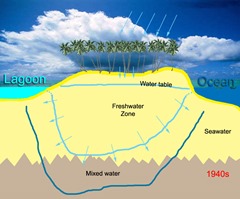 This is a side view of the island as it was in the beginning. The sandy island was covered in trees and inside of it there was a clean freshwater lens. The top of the freshwater lens is called the water table, and it is where wells could be dug to get good, clean freshwater for drinking and other uses. As rain fell from the sky, it soaked into the land and kept filling the lens, while the excess water leaked out at the sides into the lagoon and ocean. There was a sandy beach on the lagoon side and a coral rubble bank on the ocean side, protecting the island from waves. There were also some changes made during WWII with the building of the runway and borrow pits. Overall, the human population was low, so impacts on the island were few.
This is a side view of the island as it was in the beginning. The sandy island was covered in trees and inside of it there was a clean freshwater lens. The top of the freshwater lens is called the water table, and it is where wells could be dug to get good, clean freshwater for drinking and other uses. As rain fell from the sky, it soaked into the land and kept filling the lens, while the excess water leaked out at the sides into the lagoon and ocean. There was a sandy beach on the lagoon side and a coral rubble bank on the ocean side, protecting the island from waves. There were also some changes made during WWII with the building of the runway and borrow pits. Overall, the human population was low, so impacts on the island were few.
Then in the 1970’s the human population started to increase. We started to have more houses. But even at that stage, the island was not impacted that much and things went on as before.
By the 1980’s people started to build septic tanks to dispose of their sewage. And by that time, we also had a lot of seawalls built on the lagoon side. People started to use whatever sand they could find for building, and that included taking some from the ocean side beach ridges and beaches. Erosion started on both sides of the island.
Later in the 1980’s if we could have looked into the groundwater lens we would have seen sewage starting to leak into the freshwater supply for the island. The lens would have also shrunk away from the eroded areas because it needs the island’s sand to contain it. That means less freshwater, and the beginnings of pollution.
By the 1990’s erosional forces were strongly acting on the seawalls. There were by this time many more houses and people, fewer trees and rubbish had started to be a problem and was building up in the borrow pits. And there were more septic tanks and sewage pollution strongly starting to affect the freshwater lens.
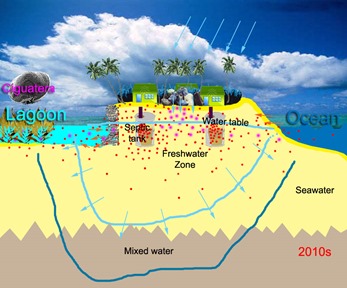 By the 2000’s tree cover was greatly thinned, there were even more people, houses, rubbish and pollution. The seawalls had broken down because of constant wave attack and the foreshore became rough and hard to use because of all the broken seawalls. Pollution into the island by that time included sewage from many, many septic tanks and chemicals leaching from the waste that had built up on the island. The freshwater could not be used for anything any more as it was unsafe.
By the 2000’s tree cover was greatly thinned, there were even more people, houses, rubbish and pollution. The seawalls had broken down because of constant wave attack and the foreshore became rough and hard to use because of all the broken seawalls. Pollution into the island by that time included sewage from many, many septic tanks and chemicals leaching from the waste that had built up on the island. The freshwater could not be used for anything any more as it was unsafe.
By 2010 the pollution had become so intense that we saw the start of algal problems in the lagoon. At first the algae grew during certain seasons and killed only the coral close to the island. But over time they became more persistent and the corals on the nearshore lagoon reefs completely disappeared. The pollution on the ocean side was less of a problem because the ocean was able to absorb it without damage.
In the last 2 years the algae in the lagoon became more and more persistent and increased. It was constantly being fed ‘fertiliser’ through the freshwater lens which carried the sewage pollution out of the island, so it grew very well.
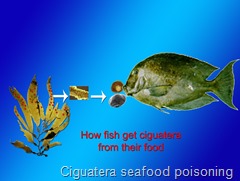 By 2013 the algae had stretched to the whole length of Fogafale on the lagoon side and had become a real nuisance. The main species, Sargassum polycystum, was and is everywhere and washes up on the shore during westerly winds. At the same time we have been having a severe outbreak of ciguatera, caused by tiny microscopic algae which live on the surface of large algae.
By 2013 the algae had stretched to the whole length of Fogafale on the lagoon side and had become a real nuisance. The main species, Sargassum polycystum, was and is everywhere and washes up on the shore during westerly winds. At the same time we have been having a severe outbreak of ciguatera, caused by tiny microscopic algae which live on the surface of large algae.
We now have an island which is eroding, has an unuseable freshwater lens, has rubbish piling up in many places, is polluted and has little resistance to waves, storms and other climate effects. The lagoon is polluted with sewage flowing out through the water lens and is choked with algae, all of which are probably related to the increasing ciguatera problems. A safe, clean environment for the people living here is going to take some work.
The Signs in Funafuti
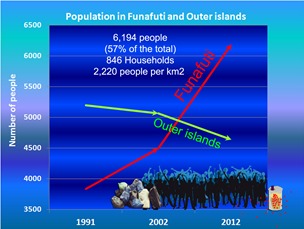 So what are the signs of all of this in Funafuti?
So what are the signs of all of this in Funafuti?
Just in the last 20 years the population of the capital has increased dramatically. There are now 6,200 people (2012 Census) living in Funafuti and this does not take into account visitors from the outer islands and overseas. That means 850 households, all of which have to have septic systems that are leaking into the water lens and the lagoon.
If we look at the lagoon shorelines we see poorly-built seawalls that soon collapse and increase the problems because they reflect wave energy, letting the waves do damage by sucking away sand. You can often see some of the algae washing up. In fact, much of the lagoon coastline is made up of collapsed seawalls and is hard to use by people who want to swim or launch their boats.
Rubbish is being stored in many places around the island. There is an area heading north where a lot of metal waste is being put in the hope of shipping it off island. And in the 10 borrow pits around the island and at waste dumps near the northern end we have a huge build-up of rubbish. The dumps are uncontrolled and the next time there is a cyclone, there is a huge risk the rubbish will be picked up and dumped in the lagoon or ocean where it will spread widely.
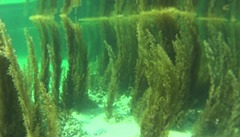 The algal overgrowth is now obvious everywhere on the lagoon side of Fogafale. This shot was taken in the lagoon off the hospital and it shows algae more than a metre tall that were never seen in Funafuti before. From the aeroplane we can see how far this extends. There are very few corals left on these near-shore reefs. The problem with algae even reaches as far out into the lagoon as the beacon. Fifteen years ago this was a beautiful coral reef with very high cover by living corals. Now it is almost 100% covered by algae. Different species than those found right next to the island, but still algae that smother corals and can lead to ciguatera. Any large algae can act as a home to the tiny algae that cause ciguatera.
The algal overgrowth is now obvious everywhere on the lagoon side of Fogafale. This shot was taken in the lagoon off the hospital and it shows algae more than a metre tall that were never seen in Funafuti before. From the aeroplane we can see how far this extends. There are very few corals left on these near-shore reefs. The problem with algae even reaches as far out into the lagoon as the beacon. Fifteen years ago this was a beautiful coral reef with very high cover by living corals. Now it is almost 100% covered by algae. Different species than those found right next to the island, but still algae that smother corals and can lead to ciguatera. Any large algae can act as a home to the tiny algae that cause ciguatera.
So all of this means that people, and especially children are swimming in polluted waters. Food is being caught in it and food is being prepared in it. Dealing with these issues is about human quality of life.
Can the Problems be Repaired?
The country’s vision is to create a healthy, educated, peaceful and prosperous Tuvalu. As part of doing that can we fix all of these environmental problems?
The answer is yes. There is a way to address all of the issues of pollution and erosion, improve the freshwater available in the ground to make more use of it and reducing the risk of ciguatera through just a few ‘smart’ projects that work together. For that we need a masterplan that will allow government, the community and donors to work together in a coordinated way. Each smart project within the plan solves more than one problem and each depends on the other to be effective.
Project 1: Centralised Sewage System
The first smart project is to create a centralised sewage system. There is probably no other capital city on earth that does not have a centralised sewage system to collect and properly dispose of sewage.
Getting rid of the sewage would mean collecting it in pipes and transporting it to the ocean side where it could be disposed of without treatment into the ocean. The ocean is very large and deep and normal waves and currents quickly mix it and dilute it. From there bacteria already in the seawater break it down and make it harmless. This would not work on the lagoon side of the island, but on the ocean side we would expect no significant impacts. This has been done on other atoll nations and has meant that the people live in a much cleaner environment and there is less impact on productive ecosystems used to living in unpolluted environments.
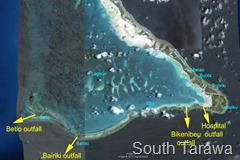 For example, Tuvalu’s neighbour Kiribati, has had a centralised sewage system in Tarawa since the 1970’s. Sewage is collected in pipes and disposed of into the ocean without treatment in 5 outfalls (the main 4 are shown here). Some studies done in the early 1990’s showed that impacts on the ocean side were limited to about 50m around each outfall.
For example, Tuvalu’s neighbour Kiribati, has had a centralised sewage system in Tarawa since the 1970’s. Sewage is collected in pipes and disposed of into the ocean without treatment in 5 outfalls (the main 4 are shown here). Some studies done in the early 1990’s showed that impacts on the ocean side were limited to about 50m around each outfall.
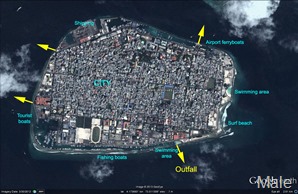 Male, the capital of Maldives also has a centralised sewage system. Sewage waste is collected from a population of 120,000 people living on an island about twice the size of Fogafale and disposed of straight to the ocean. Again the ocean is so large that impacts are not noticeable. The Tsunami Monument is close to one of the sewage outfalls for Male and when you look in the sea nearby it is clean and there are no signs of pollution or algae.
Male, the capital of Maldives also has a centralised sewage system. Sewage waste is collected from a population of 120,000 people living on an island about twice the size of Fogafale and disposed of straight to the ocean. Again the ocean is so large that impacts are not noticeable. The Tsunami Monument is close to one of the sewage outfalls for Male and when you look in the sea nearby it is clean and there are no signs of pollution or algae.
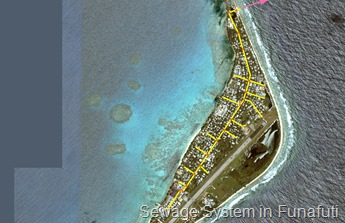 On Funafuti we could build a pipeline under the main road that collected sewage from all the houses. Sewage could be transported to the north away from the main population and disposed of just at the breakers. A small area, say ½ km around the outfall could be closed to fishing just as a precaution.
On Funafuti we could build a pipeline under the main road that collected sewage from all the houses. Sewage could be transported to the north away from the main population and disposed of just at the breakers. A small area, say ½ km around the outfall could be closed to fishing just as a precaution.
In case you are wondering all of the sewage being produced on the island now is already in contact with people and finds its way to the ocean – so the ocean is already receiving it. It does not magically disappear. The difference in having a centralised system is that we just put it directly into the ocean without polluting the land, freshwater lens or the lagoon first.
What we could expect is no more need for (poorly-maintained) household sewage systems, no more contamination of the freshwater lens so within about a year it could be used for some things, no pollution of the lagoon and within 6 months or a year we would expect the algae in the lagoon to disappear. For good. That solves a lot of problems, including removing some of the homes for ciguatera.
Project 2: Breakwater for Shoreline Protection
 The second smart project is about protecting the shoreline with a breakwater. That is, regardless of whether we have a seawall or not, we could prevent destructive waves from ever getting to the shore and that way prevent erosion.
The second smart project is about protecting the shoreline with a breakwater. That is, regardless of whether we have a seawall or not, we could prevent destructive waves from ever getting to the shore and that way prevent erosion.
This is the wave breaker at Male in Maldives. You can see the wall built out of tetrapods which destroy wave energy by smashing the waves up so that they no longer have any power to do damage like erosion. You can also see that the designers allowed for good water movements into the areas these protect.
And further along the coast these wave breakers have been designed to allow boats to safely shelter behind them. There are also openings to allow boats to move freely in and out of the harbours created. Here is a close-up of the breakers. Remember these slow water down and break up waves before they ever get to the shore – so problems of erosion are a thing of the past. When the 2004 tsunami hit Male, these structures were unaffected.
The breakwaters were a generous gift from the Government of Japan and were completed in 1990.
In Male, another great use of the breakwaters was to create swimming areas around the island and these are safe and always full of people. Two separate pools were engineered, including sandy beaches and a picnic area.
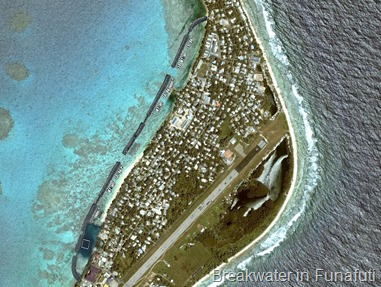 Here is how it could look in Funafuti. Imagine a place to park boats safely in most weather conditions, protect the shore from erosion and create a clean and safe swimming area for families. People would also be free to improve the seawalls, or rehabilitate beaches since the damaging waves of the westerlies would be greatly reduced or eliminated.
Here is how it could look in Funafuti. Imagine a place to park boats safely in most weather conditions, protect the shore from erosion and create a clean and safe swimming area for families. People would also be free to improve the seawalls, or rehabilitate beaches since the damaging waves of the westerlies would be greatly reduced or eliminated.
Of course using offshore breakers depends on doing the sewage system. If we did this project without cleaning up the sewage first, we would end up with even bigger problems on the lagoon side as the sewage pollution would be held in by the breakers even more than it is now.
Project 3: Zero Rubbish Island
Smart project 3 is to create a zero rubbish island. What we mean by this is that although rubbish will continue to be generated, ways are found to reuse, recycle or dispose of it that are either off-island or good for the island. That is, no rubbish gets permanently disposed of on Funafuti. No landfills, and only temporary storage as part of rubbish disposal.
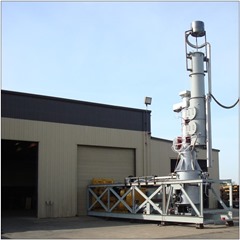 As we already know, green waste can be made into compost and used for growing. Metal wastes could be shipped off and recycled. Glass and building wastes could be crushed and reused in building or making cement products. But what do we do with the rest of the wastes, especially the plastics? There are some technologies to consider.
As we already know, green waste can be made into compost and used for growing. Metal wastes could be shipped off and recycled. Glass and building wastes could be crushed and reused in building or making cement products. But what do we do with the rest of the wastes, especially the plastics? There are some technologies to consider.
How about a small plant that converts municipal waste into energy. Not necessarily to replace the power plant, but how about feeding some energy into the grid, while saving some costs of diesel and getting rid of the waste? Burning at very high temperatures using plasma torch technology means no greenhouse emissions, and the slag produced (like a gray glassy rock) can be used in building.
Or what about a system that shreds and reuses plastics to make new materials. What about a boat or a canoe make on island from upcycled plastic?
The main point is that there is no room to permanently dispose of waste here. There is too much risk during storms and too much risk for polluting ground and lagoon water.
Project 4: Concrete Paver Roads
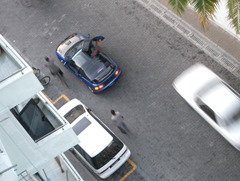 Smart project 4 is to replace the aging road with a concrete paver road which is more compatible with atolls. For this we once again visit Maldives. All of their road network is made of concrete pavers that are made in country by trained road people at PWD.
Smart project 4 is to replace the aging road with a concrete paver road which is more compatible with atolls. For this we once again visit Maldives. All of their road network is made of concrete pavers that are made in country by trained road people at PWD.
The beauty of them is that there are no potholes and no puddles – ever. No pollution of the water lens from bitumen. They can be repaired locally and last a very long time. And if you need to dig up the road to maintain a pipe or cable, you remove and put the pavers aside and replace them when you are finished. In Funafuti we have so little road, why not have a long-lasting easy-care one?
Summing Up
There are other parts needed to make these projects really effective. Like modernising the Funafuti Kaupule and PWD, banning the import of phosphates in detergents to speed up the natural recovery of the freshwater lens and lagoon and cleaning up of waste sites and tree planting which could be done by NGOs.
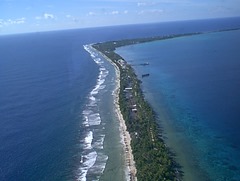 Putting these projects in place over the next few years would have a huge impact on the quality of life in Funafuti. With almost 60% of the population of the whole country now living here, cleaning up the island and make it a healthier and safer place to live is good for everyone.
Putting these projects in place over the next few years would have a huge impact on the quality of life in Funafuti. With almost 60% of the population of the whole country now living here, cleaning up the island and make it a healthier and safer place to live is good for everyone.
The outer islands are still in good shape and do not need these kinds of projects – the approach would be different. But for Funafuti putting these 4 main projects together will result in a cleaner living environment for people, and at least partial recovery of the freshwater in the ground so that it could be used for some purposes (especially during droughts). The algae will disappear from the lagoon without the need to pull it out, just because its fertilizer will be gone. The lagoon side will no longer erode, and there will be places to moor boats. In the longer run we could expect lagoon reefs to recover and ciguatera to decline, meaning better coastal fisheries. Not one of the projects alone could achieve all of this. It will be all of them working together that will improve the quality of living conditions for Tuvaluans.

